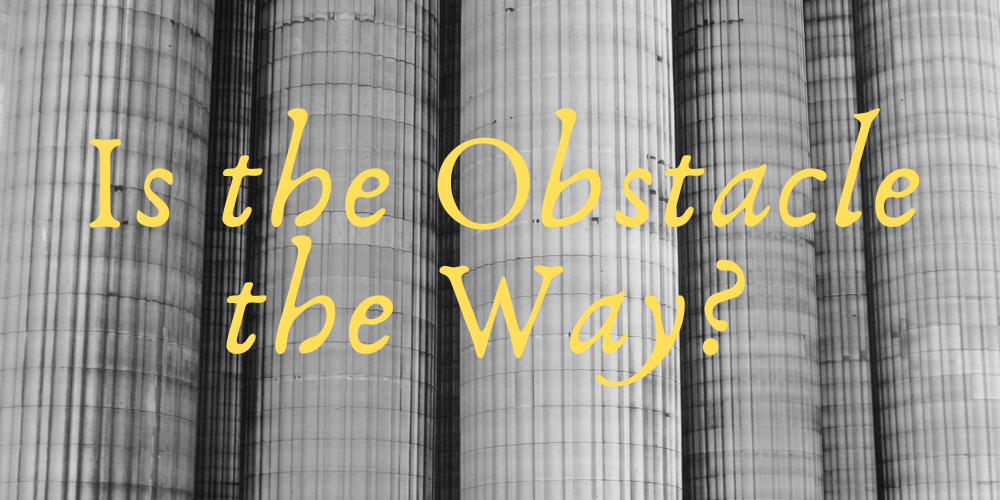I recently finished Ryan Holiday’s “The Obstacle Is the Way,” a very popular self-help book about modern stoicism, and I’m scratching my head. It’s a good book — I highlighted many passages that seemed written expressly for me — but I disagree with the premise.
The author seems to say that the path to success requires us to bypass emotions. In fact, he says, hardships should be greeted with a smile as they can always be turned into opportunities.
“Obstacles make us emotional, but the only way we’ll survive or overcome them is by keeping those emotions in check — if we can keep steady no matter what happens, no matter how much external events may fluctuate.”
The Obstacle Is the Way
Have an emotional response? “So go ahead, feel it,” Holiday writes. “Just don’t lie to yourself by conflating emoting about a problem and dealing with it. Because they are as different as sleeping and waking.”
Good Ideas Aren’t Always Good Advice
Holiday makes useful observations, but I think, on the whole, stoicism is a terrible operating system. My concern is that stoicism is too simplistic to be applied in many situations. Emotions don’t have an on-and-off switch, and human struggles are not mathematical equations. Deciding on a course of action can be messy, and there are better tools than stoicism for moving forward in complicated circumstances.
In its absolute form, stoicism is a terrible operating system for people, with the possible exception of Vulcans. I’m sure that stoicism has some nuances — its defenders will most likely say it doesn’t dismiss emotion — but my takeaway from the book is that emotion is always on the back burner. And that burner is turned off. And it’s probably in a different kitchen. The point I’m trying to make is that emotion might be there, but not in any meaningful or helpful way.
I Think CBT Is a Better Framework
I think the techniques espoused by Cognitive Behavioral Therapy (CBT) are healthier and more useful ways to approach life. CBT doesn’t tell people to turn off their emotions. Instead, it provides tools for defusing unhelpful thoughts and converting them into helpful ones.
Admittedly, the end result in some cases might be the same one reached through stoicism — but the journey to the destination is more realistic. And Holiday offers a few tips that are similar to CBT: “How we approach, view, and contextualize an obstacle, and what we tell ourselves it means, determines how daunting and trying it will be to overcome.”
I have written about CBT before, so there’s no need to repeat myself. The main difference between CBT and stoicism is that CBT tells us to acknowledge our emotions and reframe them in a helpful way. In contrast, stoicism essentially tells us to ignore our feelings. With CBT, you can reconceptualize thoughts and use them in your decision-making processes. That’s verboten in stoicism.
Holiday writes “Every obstacle is unique to each of us. But the responses they elicit are the same: Fear. Frustration. Confusion. Helplessness. Depression. Anger.”
The stoic approach is to tamp down these emotions. The CBT approach is to analyze these emotions and transform them into constructive, clearheaded ideas.
Life Can Suck
There are many things in life that just suck, for lack of a better word: Being thrown out of the house because you’re gay. Losing a family member. Losing a job and not being able to take care of your family. Processing our feelings at these inflection points lets us grow as individuals and develop our emotional intelligence. And not all emotions are negative — many are positive, helpful, and bring us happiness. Feelings, on the whole, are an asset, not a liability.1
Nonetheless, There Are Things Learn from Stoicism
I don’t want to entirely dismiss “The Obstacle Is the Way.” As I said, some truly solid advice emerges as Holiday explores stoic ideas. One that stands out to me is this:
“The path of least resistance is a terrible teacher.”
The Obstacle Is the Way
I agree with this 100%, as there are times that I have taken the path of least resistance and learned nothing. This statement rings true, and Holiday gets an A+ for condensing such a complicated issue in such a succinct statement.
Other excerpts that resonated with me:
- “Think progress, not perfection.”
- “True will is quiet humility, resilience, and flexibility.”
- “If you want momentum, you’ll have to create it yourself, right now, by getting up and getting started.”
There are a lot of good takeaways like these from Holiday’s introduction to modern-world stoicism, but I’m not buying all of what he’s selling. There’s more to be gained from acknowledging your emotional thoughts and reassessing them than from compartmentalizing them and ignoring them.
_____
1 Don’t take my word for it! Watch “Inside Out” on Disney+ to see emotions in action.
